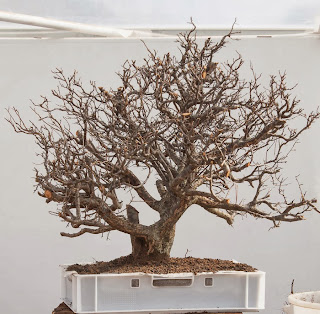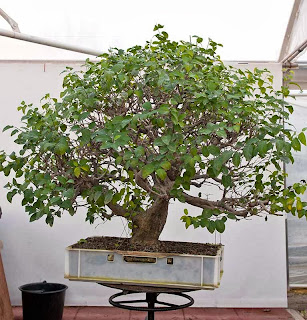Der Märchenstil
von Walter Pall
übersetzt von Gerog Maurer
Als im Sommer 2013 die internationale Bonsai Akademie bei Sebastijan Sandev stattfand, bemerkten Sebastijan und ich, dass unsere Ideen über die Gestaltung einiger Bäume so weit vom Standard-Bonsai entfernt waren, dass wir es besser als etwas anderes benennen.
Wie das alles entstanden ist:
"Sarah und John verließen am Nachmittag ihr Zuhause, weil ihre Mutter ihnen gesagt hatte, sie könne sie nicht mehr versorgen und würde sie deshalb an reiche Bauern verkaufen, welche sie wie Sklaven halten würden. Also liefen die Kinder Hand in Hand in Richtung des Waldes. Sie liefen tiefer und tiefer in den Wald hinein und wurden ziemlich verängstigt. Es wurde dunkel und der Wald machte es sogar noch dunkler. Die Kinder fühlten sich schutzlos gegenüber all den wilden Tieren und Geistern und den Bösen. Sie wurden sehr müde und schließlich sahen sie in der Ferne einen riesigen Baum. Sie waren eingeschüchtert von der Größe, dem gewaltigen Stamm und den Ästen die so dick waren wie andere Bäume und sich in alle Richtungen bewegten wie ein Oktopus. Sie trauten sich fast nicht näher ranzugehen. Da sie keine Wahl hatten, kamen sie endlich an dem Baum an, welcher sogar noch gewaltiger war, als er zuvor wirkte. Sie krochen über die enormen Wurzeln und fanden einen Spalt im Stamm, der groß genug war, um sie beide zu beherbergen. Dort fühlten sie sich sicher und schliefen ein. Dann, um Mitternacht, wachten sie auf, weil der Baum in einer tiefen, sanften Stimme zu ihnen sprach und sie bat rauszukriechen. Er wollte ihnen den Wald zeigen und sie all den Tieren und den anderen Bäumen vorstellen. Daraufhin wussten Sarah und John, dass sie an einem sicheren Ort sind und liebten den Baum. Von diesem Moment an bedeuteten Bäume etwas ganz besonderes für sie."
Als im Sommer 2013 die internationale Bonsai Akademie bei Sebastijan Sandev stattfand, bemerkten Sebastijan und ich, dass unsere Ideen über die Gestaltung einiger Bäume so weit vom Standard-Bonsai entfernt waren, dass wir es besser als etwas anderes benennen.
Wie das alles entstanden ist:
"Sarah und John verließen am Nachmittag ihr Zuhause, weil ihre Mutter ihnen gesagt hatte, sie könne sie nicht mehr versorgen und würde sie deshalb an reiche Bauern verkaufen, welche sie wie Sklaven halten würden. Also liefen die Kinder Hand in Hand in Richtung des Waldes. Sie liefen tiefer und tiefer in den Wald hinein und wurden ziemlich verängstigt. Es wurde dunkel und der Wald machte es sogar noch dunkler. Die Kinder fühlten sich schutzlos gegenüber all den wilden Tieren und Geistern und den Bösen. Sie wurden sehr müde und schließlich sahen sie in der Ferne einen riesigen Baum. Sie waren eingeschüchtert von der Größe, dem gewaltigen Stamm und den Ästen die so dick waren wie andere Bäume und sich in alle Richtungen bewegten wie ein Oktopus. Sie trauten sich fast nicht näher ranzugehen. Da sie keine Wahl hatten, kamen sie endlich an dem Baum an, welcher sogar noch gewaltiger war, als er zuvor wirkte. Sie krochen über die enormen Wurzeln und fanden einen Spalt im Stamm, der groß genug war, um sie beide zu beherbergen. Dort fühlten sie sich sicher und schliefen ein. Dann, um Mitternacht, wachten sie auf, weil der Baum in einer tiefen, sanften Stimme zu ihnen sprach und sie bat rauszukriechen. Er wollte ihnen den Wald zeigen und sie all den Tieren und den anderen Bäumen vorstellen. Daraufhin wussten Sarah und John, dass sie an einem sicheren Ort sind und liebten den Baum. Von diesem Moment an bedeuteten Bäume etwas ganz besonderes für sie."

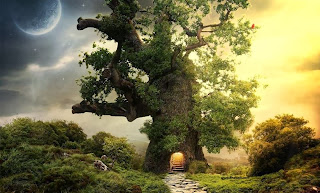
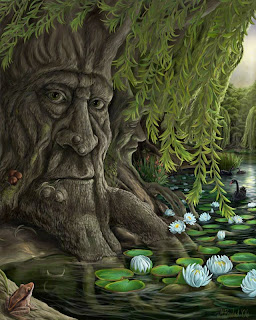
Das ist der Baum, den wir zu erschaffen versuchen. Er hat nicht viel damit zu tun, was Bonsai normalerweise ist, außer, dass er sich in Behältern, meistens nicht einmal in Schalen, befindet. Er ist gewaltig, gespenstisch, grotesk und erscheint monströs, obwohl er gleichzeitig sehr warm und freundlich ist, ein Baum so hässlich, dass er wieder schön ist. Er weiß nicht, dass er hässlich ist und es ist ihm auch egal. Viel wichtiger ist Freundschaft und Zuflucht. Es ist ein großzügiger Baum mit einem sehr weichen Kern in einer sehr harten Schale.

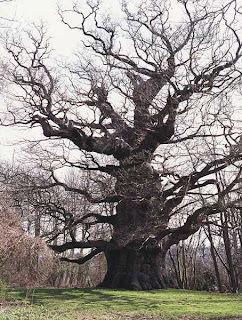

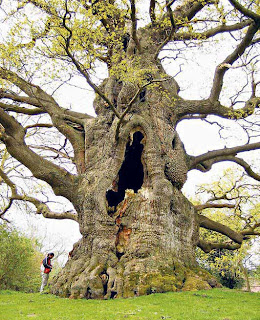

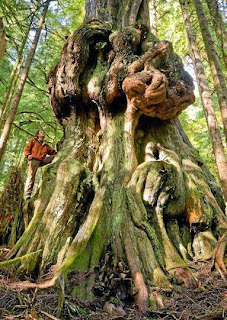


Wie macht man sich nun daran, einen Baum im Märchenstil zu gestalten? Am allerwichtigsten ist das Material. Im Allgemeinen macht es keinen Sinn, jede Form und jeden Stil den man sich gerade zur Gestaltung vorgenommen hat jedem beliebigen Material aufzuzwingen. Der Baum wird einem erzählen was er werden will. Was man als Bonsai-Material bekommt ist allgemein nicht geeignet für diese Art von Stil, es ist eher geeignet um einen Standard-Bonsai zu gestalten. Aber das "unmögliche" Material, der monströse, gesammelte Baum der so viele Optionen hat, aber keine wirklich gute, der letzte Hund, sie alle können gutes Material für den Märchenstil sein. Der große Vorteil dieses Stils ist, dass ansonsten wertloses Material für besondere Resultate genutzt werden kann. Das ist aber nicht der wahre Grund um in diesem Stil zu arbeiten. Einige werde das jedoch behaupten, aber wir sollten sie ignorieren. Sie würden es sowieso nicht verstehen. Es muss etwas in diesem chaotischen Baum sein das man sieht, was Sinn ergibt. Jedoch Sinn auf eine Märchenstil-Weise und nicht auf eine Bonsai-Weise. Es kann ein monströses Nebari sein, oder sehr merkwürdig wachsende Äste, oder große Wunden die unheimliche Höhlen sein könnten.











Hier einige Bonsai im Märchenstil:














Was ist der Unterschied zwischen dem Märchenstil und dem Naturalistischen Stil? Betrachten wir zuerst, was sie gemeinsam haben. Beide sind sehr kontrovers. Das ist immer gegeben, sobald etwas das Bonsai-Establishment bedroht. Beide bestehen bereits seit einer langen Zeit, wenn auch ziemlich unbemerkt. Die Chinesen betreiben den Naturalistischen Stil und den Märchenstil schon seit einer langen Zeit. Beide scheinen einfach zu sein, sind aber schwieriger zu meistern als der sogenannte klassische Bonsai im Neoklassischen Bonsai Stil. Beide streben danach, einen Baum zu erschaffen und unter keinen Umständen einen typischen Bonsai. Beide wollen dem Baum eine Seele geben, damit er sprechen kann. Jetzt die Unterschiede. Während im Naturalistischen Stil jemand normalerweise versucht etwas Schönes zu erschaffen, ist das nicht das Ziel beim Märchenstil. Dort versucht man etwas eindrucksvolles, einzigartiges und dominantes auf eine freundliche Art zu gestalten.
Dies befindet sich alles noch in den Kinderschuhen und es wird noch viel mehr Beispiele geben. Dies soll nur die Diskussion ins Rollen bringen.
Hier noch weitere Bilder von Bäumen in der Nature, die als Vorbilder dienen könnten.








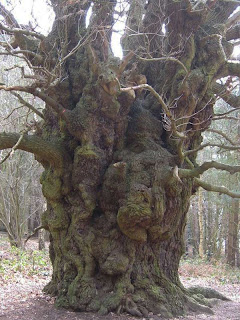








































































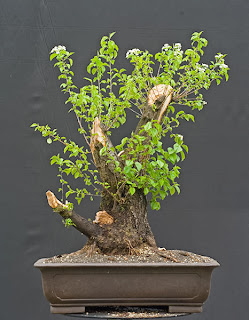

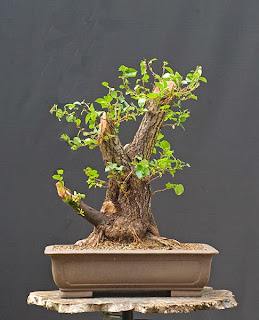





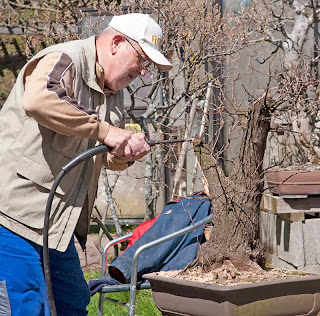




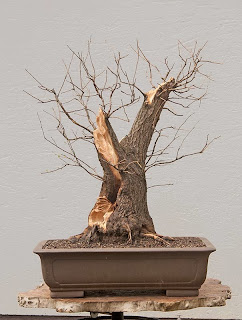




































































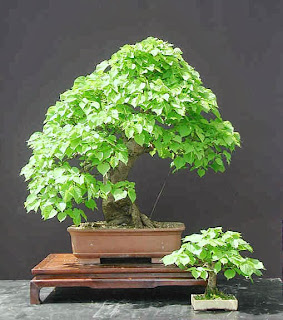




v.jpg)



v.jpg)

































































